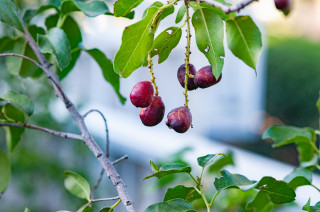
This article was originally published by a www.houzz.com . Read the Original article here. .

This article was originally published by a www.houzz.com . Read the Original article here. .

Move meals outdoors if weather allows. If mornings and evenings are still too chilly, take advantage of the warm, gentle sunshine for brunch, lunch and afternoon gatherings.
Re-create your indoor dining setup outside to turn even a quick meal into an elevated garden experience. Set a table, complete with placemats, dishes and glassware. A potted plant can serve as a centerpiece both for meals and the rest of the day.
Tip: If you find yourself heading outside often for meals or a coffee break, think about investing in outdoor-friendly tableware. Store it in a spot that’s easy to access when it’s time for a meal.
Shop for patio furniture on Houzz
This article was originally published by a www.houzz.com . Read the Original article here. .
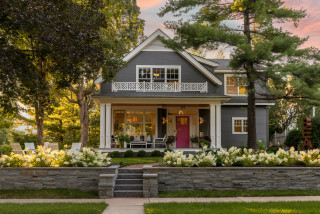
This garden in Excelsior, Minnesota, grows in memory of Beau Taunton, who tragically passed away at 22 years old from a fentanyl overdose. His mother, Kristin, wanted an area at her home where she could honor Beau, raise awareness and welcome friends, family and neighbors to gather and celebrate his life. Working with Mom’s Design Build, she transformed her front lawn into a peaceful, uplifting space for joy, love and reflection.
Yard at a Glance
Who lives here: Kristin Taunton, a mother
Location: Excelsior, Minnesota
Size: 2,400 square feet (223 square meters)
Landscape designer and contractor: Mom’s Design Build (lead designer: Heather Sweeney)
Kristin envisioned her front yard in this tight-knit neighborhood as a communal space, where loved ones could be together, remember Beau and celebrate who he was. She didn’t want to conceal what had happened or focus too heavily on loss. Instead, she chose to honor his life through this garden.
The team asked Kristin to share with them what Beau had loved, what his interests and hobbies had been, so they could capture and best express his spirit in their design. “I wanted more than a pretty garden for my son. I wanted a garden that told his story and was bold like him,” Kristin says. Special touches such as a custom sculpture and a QR code linked to his obituary allow people walking by to connect with the memory of Beau.
Find a design-build firm near you
It was important to Kristin to preserve the existing trees, particularly the maple, whose canopy we can see on the left side of this photo. Beau liked to climb and spend time in this tree, and his mom would often keep him company on the ground below.
How to Design Your Garden for More Meaning and Connection
Little Trudy catmint (Nepeta ‘Psfike’, zones 4 to 9) was planted for Beau’s cat, Keegan, who lives with Kristin now. The designers stuck to a blue, white and pop-of-pink color palette, choosing beautiful plants that would encourage Kristin to spend time outside.
Some of the other species featured include: Dakota burgundy beardtongue (Penstemon ‘TNPENDB’, zones 3 to 8), Royal Candles spiked speedwell (Veronica spicata ‘Glory’, zones 3 to 8), ‘Pink Cotton Candy’ betony (Stachys officinalis ‘Pink Cotton Candy’, zones 4 to 8), ‘PowWow White’ purple coneflower (Echinacea purpurea ‘PowWow White’, zones 3 to 8), blazing star (Liatris sp.) and boxwood (Buxus sp.).
A recirculating fountain carved from a basalt boulder gently bubbles in front of the Beau statue. It’s autofilled through a drip irrigation system the team installed in the yard. Bluestone pavers and Mexican beach pebbles surround the water feature.
Next to the fountain sits another, slightly smaller, carved stone. Water collects in the basin when it rains, creating a birdbath for the garden’s winged visitors.
10 Ways to Cope With Grief During the Holidays
Sweeney says that since these photos were taken, friends and family have left objects and mementos around the sculptures and water features. “Beau’s friends use [the space] all the time, and at night when it is lit, you can see his name,” she says. If Kristin moves, she’ll be able to bring the sculptures with her.
Regrading the front yard created the flat, usable outdoor space this seating area occupies. (The team was careful not to disturb the maple tree during construction.) The patio is Greydon sandstone. Four Adirondack chairs surround a concrete gas fire pit, which can be easily turned on and off from a switch inside the house.
Shop for patio furniture on Houzz
Winters in Minnesota are extremely cold, so Kristin turns off and drains the fountain and covers the fire pit and furniture for the season. When spring rolls around, the front yard will be ready to be enjoyed again.
More on Houzz
Read more landscape design stories
Browse landscape photos
Find a landscape designer
Shop for outdoor products
This article was originally published by a www.houzz.com . Read the Original article here. .

It can be surprising how much plastic we use in the landscape. There are those single-use black pots that garden center plants come in, for example, as well as plastic seed trays, plant labels and twine.
But with a little thought, you can replace these unsustainable items with more environmentally friendly alternatives. Use wooden labels and traditional garden string, and seek out garden centers that will recycle the black plant pots. Also, hunt around for biodegradable seed trays that will break down into the soil when they reach the end of their lifespan.
When you’re planning outdoor structures such as greenhouses, opt for glass instead of plastic if possible. The initial cost may be higher, but a model glass will last a lot longer than a cheaper plastic one.
This article was originally published by a www.houzz.com . Read the Original article here. .
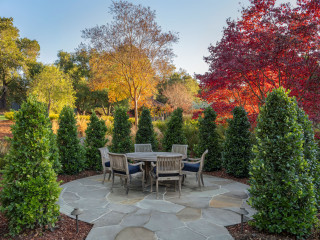
In cold-winter regions, shut off any exterior water systems before cold weather hits. Then open the tap and drain the lines to prevent damage. Finally, disconnect any hoses. Do the same for any water lines leading to an outdoor kitchen.
At the same time, drain and clean any outdoor water features, such as fountains and ponds.
In warmer regions, check that your irrigation system is still working correctly. Repair or replace any sprinkler heads or drip system components as needed. Cut back on watering frequency as the weather cools. If rainfall is sufficient, turn the system off.
Even if you live in a warmer area, it’s a good idea to keep an eye on winter forecasts. Insulate exterior pipes and taps if a freeze is predicted, especially one that will last several days. Another option is to open the taps slightly to allow water to slowly drip out.
This article was originally published by a www.houzz.com . Read the Original article here. .
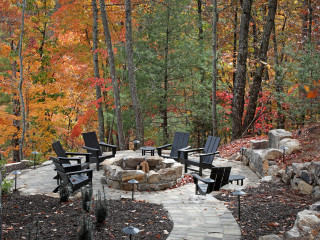
Keep on top of garden maintenance even as you relax your winter cleanup approach. Remove dead or weak branches from trees and shrubs to prevent them from breaking off and causing damage during storms. You’ll also want to remove any rotting stems on herbaceous perennials, and any diseased foliage.
Replace fading annuals with cool-season choices — especially in warm-winter areas — to keep some pops of color in your landscape. Remove and compost any remaining warm-season annual edibles and herbs. Prune back woody herbs that can handle the cold, such as rosemary and thyme, by about two-thirds to prepare them for winter. To eke out the last of the harvest, dry any herbs and preserve the last of any fruits and vegetables.
Are there annuals and annual edibles, such as tomatoes, that you love having in your garden? Before you move them to the compost pile, gather some seeds to get started for next year.
This article was originally published by a www.houzz.com . Read the Original article here. .

Take in the fall foliage on a hiking trail, at a local park or in your yard. Turn raking leaves from a chore into a chance to appreciate Mother Nature’s show. Once you have a pile of leaves, it might just be time to channel your inner child and jump in.
Rather than immediately bagging your leaves, consider using some or all of them as a natural mulch. You can spread a thin layer over your garden beds or lawn, allowing the leaves to decompose and add nutrients to the soil. Don’t make the layer too thick, especially over a lawn, as you don’t want to kill whatever might be growing underneath. Use a lawnmower or garden shredder to turn the leaves into smaller pieces.
5 Ways to Put Fall Leaves to Work in Your Garden
This article was originally published by a www.houzz.com . Read the Original article here. .
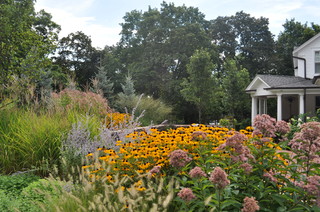
Purple coneflower and Russian sage make an all-star combination for late-summer and fall perennial beds. Purple coneflower (Echinacea purpurea, zones 3 to 8), native to Eastern North America, are cold-hardy perennials that bloom for months, attracting native bees and butterflies. After the bloom, the flowers’ spiky deep-orange centers can be left in the garden as decorative seedpods (and a feast for birds).
With its pale stems and delicate lavender-blue flowers, Russian sage (Perovskia atriplicifolia, zones 5 to 9) adds an airy quality to beds, appearing like a pale-colored cloud when planted in drifts. Russian sage blooms from July to October.
Both plants are drought-tolerant, making them a good pair for a tough, low-water spot like this sidewalk garden by Garden Stories in Portland, Oregon.
Water requirement: Moderate to low, once established
Light requirement: Full sun
20 Favorite Flowers for the Fall Landscape
This article was originally published by a www.houzz.com . Read the Original article here. .
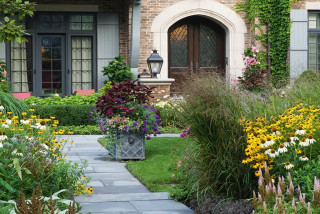
While some bulbs that need a colder winter may rebloom when planted in the garden, many will produce only leaves in subsequent years. To get a good show, consider treating bulbs like annuals.
Cold-winter climates. Winter chill isn’t an issue for cold-hardy bulbs, but freeze-and-thaw cycles can damage them. If the ground won’t be covered in snow or frozen, provide a layer of mulch.
You may also need to dig up tender bulbs such as canna lilies, dahlias and gladioluses, and overwinter them in a cool, dry location.
This article was originally published by a www.houzz.com . Read the Original article here. .
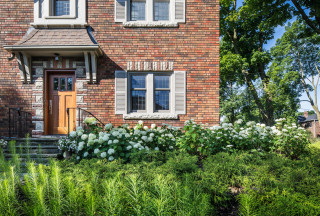
If you’re looking for ways to feel more at peace in your garden, here are nine ideas for cultivating serenity. Which ones resonate with your vision of a tranquil garden?
This article was originally published by a www.houzz.com . Read the Original article here. .
Chicago is known for its brutally cold winters and hot, dry summers. “Just a few hours north and south of here is a very different climate,” says Jeff True.
Turn to native hardwoods. True says that native hardwood trees can handle weather extremes and are often his starting points. These include several maples, such as red maple (Acer rubrum, zones 3 to 9), sugar maple (A. saccharum, zones 3 to 8; shown here), silver maple (A. saccharinum, zones 3 to 9) and Freeman’s maple (A. x. freemanii, zones 5 to 8).
Native white oak (Quercus alba, zones 3 to 9), which is the state tree of Illinois, is also a tried-and-true favorite, as are swamp white oak (Q. bicolor, zones 3 to 8), Chinquapin oak (Q. muehlenbergii, zones 5 to 7) and shagbark hickory (Carya ovata, zones 4 to 8). “I personally love Kentucky coffeetree (Gymnocladus dioicus, zones 3 to 8) and hackberry (Celtis occidentalis, zones 2 to 9),” True says.
He adds that the new elm varieties resistant to Dutch elm disease, such as Triumph elm (Ulmus ‘Morton Glossy’, zones 4 to 7), are fast-growing, allowing them to fill in spaces quickly.
8 Reasons to Plant a Great Tree